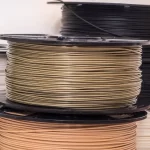The DXF (Drawing Exchange Format, or Drawing Interchange(X) Format) was initially developed as the native file type for the AutoCAD design package in the early 1980s. This format brought a unique approach to storing 2D and later 3D design data. DXF was developed by AutoDesk for their AutoCAD package and is open to use by other applications. AutoDesk led the drive towards interoperability, seeking the “high ground” of a universal CAD data storage format. Interestingly, the DXF format has not only survived the 2D to 3D shift in product development packages but has thrived and retained its relevance. DXF is a widely trusted and used interchange tool between CAD and CAM packages, providing error-free, highly accurate data and ease of use that the market likes.
STL (STereo Lithography or Standard Triangle Language or Standard Tessellation Language) is the “standard” file type used by the majority of 3D printers. It’s an old format that has no color or texture information. STLs store a series of points on the surface of an object as geometric data. These triangular subsurfaces form a net that describes the outward 3D shape but has no information about thickness, color, or texture. DXFs store the complete design information for construction data in the file. This makes DXF ideal for accurately representing the shapes and relationships of both 2D and 3D parts. When you have a DXF file and need to convert it to an STL format for your slicer software, several online programs can do this, including various CAD packages. Most DXF file converters are either free downloads or online tools that handle a wide range of formats.
This article will discuss the steps in DXF to STL file conversion using Spin 3D, review their definitions and qualities, and examine how to convert and open DXF files.
.webp)
